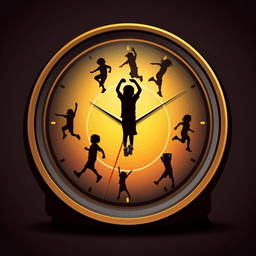
Medicine and Health
24-hour movement behaviours and mental health in non-clinical populations: A systematic review
R. Dale, T. O'rourke, et al.
Discover how sleep, physical activity and sedentary time together shape mental well-being across the day in a systematic review of 103 studies. Most adolescent (93%) and adult (89%) studies—and many child studies (70%)—found positive links between movement composition and mental health, though evidence certainty is low. Research conducted by Rachel Dale, Teresa O'Rourke, Barbara Nussbaumer-Streit, and Thomas Probst.
~3 min • Beginner • English
Introduction
Modern lifestyles increasingly promote sedentary behaviours and suboptimal sleep, despite robust evidence that sleep quality and duration, sedentary time, and physical activity (light and moderate-to-vigorous) influence health. Because time in a 24-hour day is finite, time spent in one movement behaviour necessarily displaces others; consequently, movement behaviours should be studied compositely rather than in isolation. Building on 24-hour movement guidelines established for children and adults, the research question/hypothesis of this review was that movement behaviour compositions more aligned with these guidelines would be positively associated with mental health outcomes across non-clinical children, adolescents, and adults. The purpose was to synthesise evidence on how combined daily movement behaviours (sleep, sedentary/screen time, LPA, MVPA, muscle strengthening) relate to mental health (e.g., depression, anxiety, well-being) across populations and analytic methods, to clarify consistencies, disparities, and gaps and to inform public health and mental health promotion.
Literature Review
Prior syntheses primarily examined physical health outcomes of 24-hour movement compositions. Mental health played little role in guideline development, yet individual behaviours are known to affect mental health: meta-analyses show physical activity reduces depression and anxiety; reduced sedentary time improves well-being; and better sleep enhances multiple mental health measures. Three systematic reviews focused on children/adolescents reported that meeting combinations of sleep, physical activity, and limited screen/sedentary time was associated with better socioemotional outcomes, health-related quality of life, and lower depression/anxiety, with dose–response patterns. A recent scoping review in youth found associations with mental health for sleep (~70% of articles), physical activity (~60%), and sedentary behaviour (~60–70%). However, adult populations were largely absent from prior reviews, and newer studies across age groups have employed compositional data analysis (CoDA), isotemporal substitution models (ISM), and guideline adherence combinations, warranting an updated, comprehensive review including adults.
Methodology
Registration and reporting: Preregistered on PROSPERO (CRD42022312717) and conducted per PRISMA guidelines. Eligibility criteria (PICOS): Population—non-clinical general samples of children (<12 years), adolescents (13–18), adults (>18); excluded clinical populations requiring acute/hospital care and special movement requirements (e.g., paraplegia, elite athletes). Exposure—composition of time across 24 hours in ≥3 movement behaviours (sleep, sedentary, screen time, muscle strengthening, LPA, MVPA) or adherence to recommendations for ≥3 behaviours; objective (e.g., accelerometers) or self-/parent-report accepted. Comparator—compositional distributions or combinations of guideline adherence; reallocation analyses in longitudinal or modelling studies included. Outcomes—mental illness symptoms or mental well-being (e.g., depression, anxiety, stress, quality of life, flourishing). Designs—controlled intervention studies (RCTs, non-randomised) and observational (cross-sectional, cohort, prospective/retrospective) using methods that account for 24-hour composition (e.g., CoDA, ISM, guideline combination analyses, latent classes). Information sources and search: PubMed, Scopus, Embase; English/German; searches on 02/15/2022 with update on 08/26/2024. Core search combined movement behaviour terms (including sleep, sedentary, activity) with mental health terms; strategies validated by an information specialist. Study selection: Duplicates removed; titles/abstracts dual screened; full texts dual assessed (n=168). PRISMA counts: records identified=3804 (Scopus=1435; Embase=1206; PubMed=1163); duplicates removed=1842; screened=1962; reports assessed=168; excluded=64 (movement behaviours not combined=34; combined score included non-movement behaviours=10; <3 behaviours=14; movement & mental health not compared=6; clinical population=2). Included studies=103. Data extraction: Design, population, sample size, age, sex, movement behaviours and measurement methods, mental health measures, covariates, analytic techniques; extracted by RD and checked by TO; results from most fully adjusted models recorded. Risk of bias and certainty: RoB2 for RCTs, JBI for cross-sectional, Newcastle–Ottawa Scale for cohorts; GRADE applied to common outcomes (depression, anxiety, general mental health, emotional problems, QoL, stress) using an approach for absence of pooled estimates. Synthesis: Meta-analysis was not feasible due to heterogeneity (populations, measures, analyses); narrative synthesis stratified by age group and outcome, and by analysis type (guideline adherence, CoDA, ISM, latent profiles/cluster analyses). Measurement notes: 35% of cross-sectional and 44% of longitudinal studies measured all movement exposures with valid/reliable methods; 78% measured mental health outcomes with valid/reliable tools. Many studies (n=35) used accelerometers; others used validated questionnaires or single/unvalidated items.
Key Findings
Study characteristics: 103 studies (2014–2024); sample sizes 73–238,440; 27 in children, 41 in adolescents, 46 in adults; 87 cross-sectional, 23 longitudinal (7 with both analyses), 1 RCT. Overall associations: at least one significant positive association between movement behaviours and mental health was reported in 19/27 child studies (70%), 38/41 adolescent studies (93%), and 41/46 adult studies (89%); certainty of evidence very low across outcomes. Children: Emotional problems—12/18 studies found associations; meeting more recommendations (especially limiting screen time) linked to lower internalising/externalising problems; CoDA commonly linked higher sedentary/screen time with more problems; ISM showed replacing sleep or MVPA with sedentary/screen time increased problems; some links between high MVPA and externalising issues. Depression—6/7 studies (all guideline-based) found lower depression with meeting individual (ST, MVPA, sleep, sedentary) or three recommendations; one CoDA study reported no association. Anxiety—4/4 studies found lower anxiety when meeting three recommendations and some individual/combo recommendations. Resilience—higher resilience associated with meeting sleep, MVPA+ST, or more guidelines; Self-esteem—no associations in 2 studies. Quality of life/general mental health—QoL mixed (1 positive, 2 null); better general mental health and well-being with more guidelines and specifically MVPA and lower ST. Adolescents: Emotional problems—10/11 positive; more recommendations met linked to fewer problems; CoDA and ISM indicated higher sleep/LPA/MVPA and lower sedentary/ST beneficial. Depression—21/23 positive; 12/13 guideline studies showed dose-response benefits; CoDA linked higher sleep/LPA/MVPA and lower sedentary/ST with lower depression; ISM typically showed replacing ST with sleep or MVPA reduced depression; latent profiles identified high MVPA/low ST as protective. Anxiety—13/13 measured; guideline adherence (especially sleep and low ST) beneficial; CoDA/ISM supported higher sleep/MVPA and lower ST/sedentary. Resiliency/self-esteem/flourishing—beneficial patterns consistently involved low ST and higher sleep/MVPA; ISM benefits from reallocating ST to sleep/MVPA. QoL/life satisfaction and general mental health—consistently positive; CoDA linked higher sleep/MVPA and lower sedentary to higher life satisfaction; higher ST associated with higher distress in one CoDA study. Stress—lower with sleep recommendation and with reallocations to MVPA. Loneliness—higher among those not meeting any recommendation. Adults: Depression—25/29 positive; 11/12 guideline studies: more recommendations met linked to lower depression; CoDA often showed higher sedentary/lower MVPA linked to higher depression; sleep effects mixed (some more sleep linked to higher depression, others lower); ISM strongly consistent: 13/15 analyses found replacing sedentary time with MVPA reduced depression, with several also favoring replacing sedentary with sleep or sleep with MVPA. Anxiety—9/13 positive; guideline adherence associated with lower anxiety; CoDA mixed, often higher sedentary linked to higher anxiety; ISM variably positive (sedentary→MVPA beneficial). Stress—5/7 positive; guideline adherence beneficial; ISM showed sedentary→sleep or MVPA reduced stress; CoDA mixed. General mental health/mood/well-being—14/14 positive; guideline adherence beneficial; CoDA frequently linked higher MVPA (and in some cases higher sleep/lower sedentary) to better outcomes; ISM generally found replacing sedentary with MVPA/sleep/LPA and replacing sleep with MVPA improved outcomes. Quality of life/happiness—5/7 positive; guideline adherence beneficial; CoDA and ISM indicated MVPA and replacing sedentary with MVPA or sleep improved QoL/happiness; RCT mediation showed intervention-driven improvements in composite activity-sleep linked to better QoL. Loneliness—lower with more guideline adherence; CoDA/ISM suggested higher MVPA and reduced sedentary time reduce loneliness. Work-related mental health—mostly null, with one CoDA showing higher sleep/lower sedentary associated with higher work engagement. PTSD—meeting sleep recommendations associated with fewer PTSD symptoms in military and student samples. Age-group comparison: Associations most consistent and strongest in adolescents (especially higher sleep and lower ST), robust in adults (notably reducing sedentary time and increasing MVPA), and mixed in children (particularly for emotional problems).
Discussion
Findings support the hypothesis that healthier 24-hour movement compositions are associated with better mental health across non-clinical populations, with strongest and most consistent associations in adolescents and adults. In adolescents, higher sleep and lower recreational screen/sedentary time, coupled with adequate MVPA, were repeatedly linked to fewer emotional problems, depression, and anxiety, and better resiliency, self-esteem, flourishing, and general well-being. In adults, reducing sedentary time—often via reallocations to MVPA—was a recurrent pathway to improved depression, anxiety, stress, general mental health, QoL, and reduced loneliness. Children showed more mixed results, particularly for emotional problems; potential reasons include lower variability in behaviours and outcomes, methodological sensitivities, and developmental factors. Across analytic methods (guideline adherence, CoDA, ISM, latent profiles), results consistently pointed toward benefits of healthier movement compositions, underscoring the relevance of integrated daily movement behaviours rather than siloed metrics. Public health and mental health campaigns may leverage these findings to promote adherence to 24-hour movement guidelines and targeted strategies (e.g., reducing sedentary/screen time, prioritizing sleep regularity, increasing MVPA) tailored to age-specific needs. However, causal inference remains limited by the predominance of observational designs and heterogeneity in measures.
Conclusion
Across 103 studies, most reported that healthier 24-hour movement behaviour compositions are associated with better mental health outcomes, particularly in adolescents and adults. The review advances the field by integrating evidence across age groups and analytic approaches, highlighting consistent benefits of reducing sedentary/screen time, prioritizing sleep, and increasing MVPA for diverse mental health indicators. Implications include informing cost-effective mental health promotion and prevention strategies and public health messaging aligned with 24-hour movement guidelines. Future research should prioritize randomized controlled trials and robust longitudinal designs to establish causality; expand representative adult general population samples; examine cultural and environmental moderators beyond predominantly Canadian, Chinese, and U.S. contexts; and identify which types and qualities of activity (e.g., leisure vs. occupational) and sleep characteristics most influence mental health. Mechanistic investigations (e.g., resource activation, mastery/coping pathways) may clarify how movement compositions confer mental health benefits.
Limitations
Meta-analysis was precluded by substantial heterogeneity in populations, movement behaviour measurement (only 35% of cross-sectional and 44% of longitudinal studies measured all behaviours with validated/objective tools), outcomes (though 78% used validated measures), and analytic methods. Most studies were observational, resulting in very low certainty of evidence across key outcomes per GRADE. Few controlled trials (one RCT) limit causal conclusions. Adult samples were heterogeneous and often non-representative; geographic concentration (Canada, China, USA) constrains generalizability, with minimal evidence from African contexts. Some studies used single/unvalidated items for exposures or outcomes; a small number included participants (e.g., cancer survivors) who may overlap with clinical contexts though not meeting acute care exclusion criteria.
Related Publications
Explore these studies to deepen your understanding of the subject.







